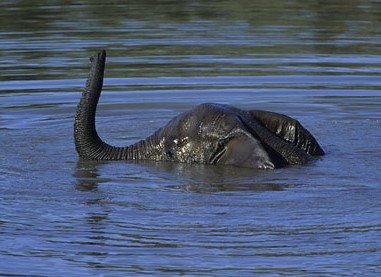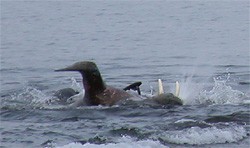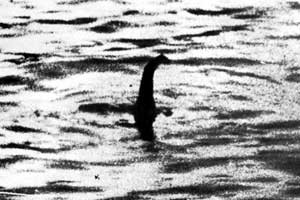
November 2, 2006

First the old 1970s theory that all the Nessies are swimming elephants was retold in new clothing in March 2006, and now we are hearing that the Scottish Lake Monsters cannot be plesiosaurs. Okay, tell me something I don’t know, please!

What is it? See below.
The news out of Scotland, as for example in the Scotsman article, “Scientist pours cold water on Loch Ness dinosaur theory”, is propelling the finding that Nessie is not a plesiosaur, which really is not a dinosaur anyway (but that’s another story).

Here’s part of what the “breaking news” services you will read today shall be summarizing:
Dr Leslie Noe, a palaeontologist at Cambridge University’s Sedgwick Museum, discovered that the plesiosaur would have been unable to lift its head up, swan-like, out of the water.
Most scientists believe the creatures became extinct with the other dinosaurs, but some insist it is possible that after the last Ice Age, some plesiosaurs may have been stranded in the 23-mile-long loch, which was connected to the sea.
The plesiosaur has a prominent small head on a long neck and a round body, and is the most popular explanation for mythical Nessie.
The classic view of the plesiosaur, shown above in this archival woodcut, is being revised. Click on this image for a larger version.
Dr Noe, whose findings are reported in this month’s New Scientist, told experts at a meeting of the Society of Vertebrate Palaeontology in Canada, that plesiosaurs used their long necks to reach down and feed on soft-bodied animals living on the sea floor. By examining fossils of a plesiosaur, Muraenosaurus, and by calculating the articulation of the neck bones, Dr Noe concluded the neck was flexible and could move most easily when pointing down.
Dr Noe said: “The neck was a feeding tube, collecting soft-bodied prey. The osteology of the neck makes it certain the plesiosaur could not lift its head up, swan-like, out of the water.”
However, the findings did not surprise George Edwards, one of the world’s foremost authorities on the monster, who took a photograph of a unknown “creature” with a black hump he spotted on the loch in June 1986. Mr Edwards, from Drumnadrochit, who runs Loch Ness cruises on his boat, the Nessie Hunter, said: “Most people don’t support the dinosaur theory. The creature is some entirely new species. When you consider that every year in the open seas thousands of new species are discovered, this is the most likely explanation. But there’s no doubt that a creature, one with a single hump, which most people report, does exist.”
Okay, why is Dr. Noe still using the classic Surgeon’s Photo Nessie as the iconic strawman? (That’s probably a tail shown in the photos, anyway, but then, that’s another story too.) Of course, Dr. Kenneth Wilson’s cropped frame from one of his two pictures is what Noe is talking about because that’s the “imprinted image” that most of the public has as “the Loch Ness Monster.”
My thoughts are that as opposed to what the popular media either assumes or attempts to convey, most cryptozoologists have not supported “dinosaurs” or “plesiosaurs” in Loch Ness for years, but consider various other possible candidates, from eels to fish to unknown seals, as more worthy.
For example, I support the notion that a mammal, an as-yet unidentified species of large pinniped, is what is being seen. The myth of a swam-necked animal is long dead, and the most frequent sighting is of an animal’s body resembling the bobbing main torso of a walrus coming out of the water.

What is it? This is a flipper of a walrus extended from the water.
Furthermore, some 20+ land sightings and such details like hair being seen on the body support the mammalian theories as I overviewed in the past.
Male pinnipeds are enjoying a swim, here, in the above image, which can be enlarged with a click on the photograph. Nessies are not walruses, but the Loch Ness Monsters may be more closely related to walruses and elephant seals than to plesiosaurs, that’s for sure.
About Loren Coleman
Loren Coleman is one of the world’s leading cryptozoologists, some say “the” leading living cryptozoologist. Certainly, he is acknowledged as the current living American researcher and writer who has most popularized cryptozoology in the late 20th and early 21st centuries.
Starting his fieldwork and investigations in 1960, after traveling and trekking extensively in pursuit of cryptozoological mysteries, Coleman began writing to share his experiences in 1969. An honorary member of Ivan T. Sanderson’s Society for the Investigation of the Unexplained in the 1970s, Coleman has been bestowed with similar honorary memberships of the North Idaho College Cryptozoology Club in 1983, and in subsequent years, that of the British Columbia Scientific Cryptozoology Club, CryptoSafari International, and other international organizations. He was also a Life Member and Benefactor of the International Society of Cryptozoology (now-defunct).
Loren Coleman’s daily blog, as a member of the Cryptomundo Team, served as an ongoing avenue of communication for the ever-growing body of cryptozoo news from 2005 through 2013. He returned as an infrequent contributor beginning Halloween week of 2015.
Coleman is the founder in 2003, and current director of the International Cryptozoology Museum in Portland, Maine.
Filed under Breaking News, Cryptomundo Exclusive, CryptoZoo News, Cryptozoology, Lake Monsters, Living Dinosaurs, Loch Ness Monster